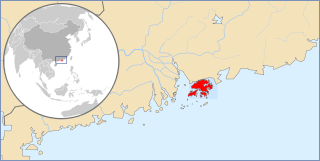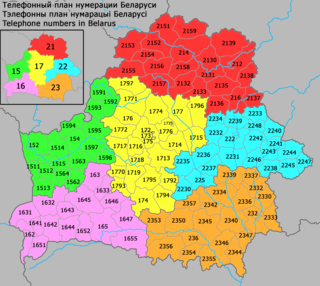An automatic number announcement circuit (ANAC) is a component of a central office of a telephone company that provides a service to installation and service technicians to determine the telephone number of a telephone line. The facility has a telephone number that may be called to listen to an automatic announcement that includes the caller's telephone number. The ANAC facility is useful primarily during the installation of landline telephones to quickly identify one of multiple wire pairs in a bundle or at a termination point.

The North American Numbering Plan (NANP) is a telephone numbering plan for twenty-five regions in twenty countries, primarily in North America and the Caribbean. This group is historically known as World Zone 1 and has the telephone country code 1. Some North American countries, most notably Mexico, do not participate with the NANP.
Premium-rate telephone numbers are telephone numbers that charge callers higher price rates for select services, including information and entertainment. A portion of the call fees is paid to the service provider, allowing premium calls to be an additional source of revenue for businesses. Tech support, psychic hotlines, and adult chat lines are among the most popular kinds of premium-rate phone services. Other services include directory enquiries, weather forecasts, competitions and ratings televoting. Some businesses, e.g. low-cost airlines, and diplomatic missions, such as the US Embassy in London or the UK Embassy in Washington, have also used premium-rate phone numbers for calls from the general public.
A toll-free telephone number or freephone number is a telephone number that is billed for all arriving calls. For the calling party, a call to a toll-free number from a landline is free of charge. A toll-free number is identified by a dialing prefix similar to an area code. The specific service access varies by country.
A telephone numbering plan is a type of numbering scheme used in telecommunication to assign telephone numbers to subscriber telephones or other telephony endpoints. Telephone numbers are the addresses of participants in a telephone network, reachable by a system of destination code routing. Telephone numbering plans are defined in each of the administrative regions of the public switched telephone network (PSTN) and in private telephone networks.

In the United Kingdom, telephone numbers are administered by the Office of Communications (Ofcom). For this purpose, Ofcom established a telephone numbering plan, known as the National Telephone Numbering Plan, which is the system for assigning telephone numbers to subscriber stations.

The Australian telephone numbering plan governs the allocation of telephone numbers in Australia. It has changed many times, the most recent major reorganisation by the Australian Communications and Media Authority taking place between 1994 and 1998.
Delilah Rene Luke is an American radio personality, author, and songwriter, best known as the host of a nationally syndicated nightly U.S. radio song request and dedication program, with an estimated 8 million listeners. She first aired in the Seattle market as Delilah Rene, though she is now known simply as Delilah.
In Argentina, area codes are two, three, or four digits long. Local customer numbers are six to eight digits long. The total number of digits is ten, for example, phone number (11) 1234-5678 for Buenos Aires is made up of a 2-digit area code number and an 8-digit subscriber's number, while (383) 123-4567 would be an example of a Catamarca number.

Telephone numbers in Hong Kong are mostly eight-digit. Fixed land line numbers start with 2 or 3, mobile (cellular) phone numbers with 4, 5, 6, 7, 8, or 9, pager numbers with 7 and forwarding service with 8. Since the end of 1989, there have been no area codes within Hong Kong.

Numbers on the Irish telephone numbering plan are regulated and assigned to operators by ComReg.
Widespread UK telephone code misconceptions, in particular brought on by the Big Number Change in 2000, have been reported by regulator Ofcom since publication of a report it commissioned in 2004.

936 140-35-67 dialling plan for mobile networks and new landline operators is closed; all subscriber numbers must be dialled in full. For landline numbers starting with 02, the dialling plan used to be open; the trunk digit and area code could be omitted if the caller was in the same area code as the callee. However, starting May 3, 2008, all landline numbers must be dialled in full.
A feature group, in North American telephone industry jargon, is most commonly used to designate various standard means of access by callers to competitive long-distance services. They defined switching arrangements from local exchange carriers central offices to interexchange carriers. These arrangements were described in an official tariff of the National Exchange Carrier Association, filed with the Federal Communications Commission (FCC).

The regulation of telephone numbers in Germany is the responsibility of the Federal Network Agency of the German government. The agency has a mandate to telecommunications in Germany and other infrastructure systems.
A choke exchange is a telephone exchange designed to handle many simultaneous call attempts to telephone numbers of that exchange. Choke exchanges are typically used to service telephone numbers of talk radio caller and contest lines of radio stations and event ticket vendors.
National conventions for writing telephone numbers vary by country. The International Telecommunication Union (ITU) publishes a recommendation entitled Notation for national and international telephone numbers, e-mail addresses and Web addresses. Recommendation E.123 specifies the format of telephone numbers assigned to telephones and similar communication endpoints in national telephone numbering plans.

A telephone number is a sequence of digits assigned to a landline telephone subscriber station connected to a telephone line or to a wireless electronic telephony device, such as a radio telephone or a mobile telephone, or to other devices for data transmission via the public switched telephone network (PSTN), or other public and private networks. Modern smart phones have added a built-in layer of abstraction whereby individuals or businesses are saved into a contacts application and the numbers no longer have to be written down or memorized.
Ranges for fictitious telephone numbers are common in most telephone numbering plans. One of the main reasons these ranges exist is to avoid accidentally using real phone numbers in movies and television programs because of viewers frequently calling the numbers used. In North America, the area served by the North American Numbering Plan (NANP) system of area codes, fictitious telephone numbers are usually of the form (XXX) 555-xxxx. The use of 555 numbers in fiction, however, led a desire to assign some of them in the real world, and some of them are no longer suitable for use in fiction. Other areas have different fictitious telephone numbers.

Belarus began using its own country code +375 in 1995, replacing the +7 international country code inherited from the Soviet Union. The local numbering plan was inherited from the Soviet Union and remains with few changes.








